The harder the variant, the more glorious the triumph.
So back in 1968, Mad Magazine pulled this cover gag on issue #123:
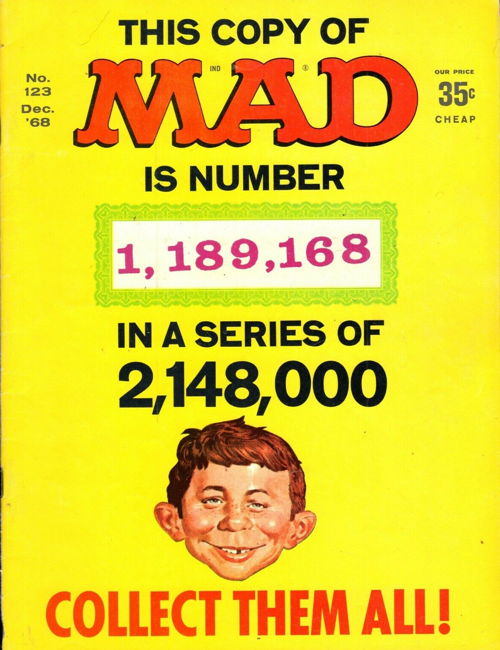
…part of the joke being there were only (as far as anyone knows) four different serial numbers printed on the covers. In essence, that makes this one of the first “variant” covers in the modern sense (predating that darn Man of Steel #1).
Now, I don’t think anyone expected fans to actually collect all four variants, despite what it says there on the cover. Clearly the multiple printed numbers were only there to add a bit of verisimilitude to the gag. Now of course Mad would eventually, actually, once the technology existed, put genuine serialized numbering on some covers, like this issue from 1995:
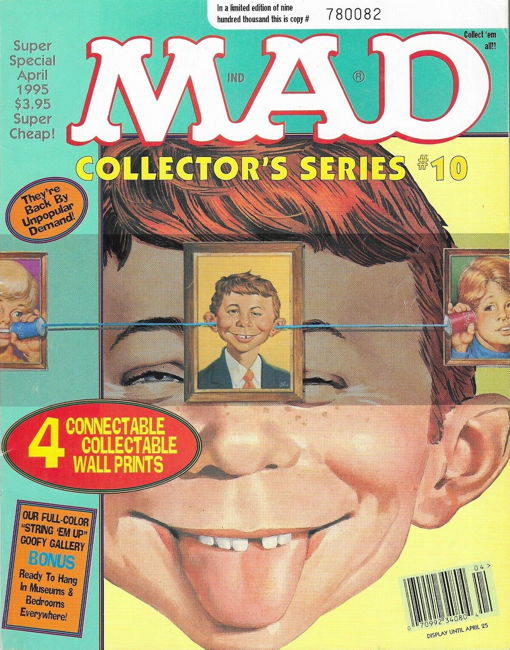
This reminds me of ack in ye olden tymes of the 1980s, I was, I don’t know, 12 or 13 or something like that, when I first saw a printed personlized message in one of the magazines to which I subscribed. (It was either Games or Omni — yes I know that’s a little weird.) Not just my address being printed directly onto the cover instead of being printed first on a mailing label that was glued to the mag. But an actual message to me, using my name, printed (and memory fails me here, as I haven’t thought about this in decades) on the cover, or inside the magazine itself. Look, I don’t know when this sort of thing became available, if it’d been happening elsewhere before it showed up in the mags I read, but all I know is that I thought that was pretty cool. My copy of the magazine was personalized to me, and totally different from everyone else’s copy, which technically was true before anyway just given the mailing label, but you know what I mean. But it was only a short leap from this to putting a sequence of “limited edition” serial numbers on a cover.
For the purposes of my ongoing discussion, this type of “variant” cover I’ve been discussing only just barely counts. Well, Mad #123 does, obviously, but the others…when we think of variant covers on comics, we’re likely thinking of comics marketed with two or more covers, often with differing art or enhancements or even just coloring.
Also, there’s intent…the typical variant covers are there to either get a customer to buy more than one cover, or to provide enough variations that a customer otherwise possibly not interested in the publication might spot a cover he likes and is enticed to buy.
Serial numbers printed on a comic’s cover are a sales enticement as well, but not in the same way. Different numbers on different copies do make them variants, when you get down to it, but, like no one’s literally “collecting them all.” Or, come to think of it, maybe someone’s trying…I’ve been in comics retail for nearly three and a half decades, I know what kind of stuff you weirdos get up to. That said, a serial number implies “limited edition” — “there’s only so many of these in existence!” — so that part of it does (or hopefully does) get a customer’s attention and with it, a purchase.
One publisher that took it to an extreme, and made serial numbering part of their trade dress, was Triumphant Comics:
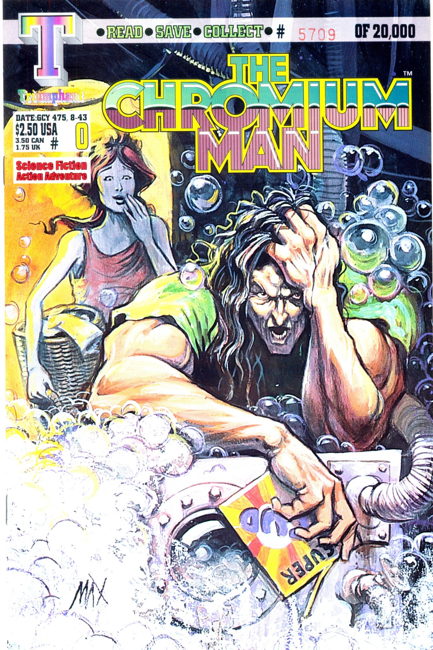
A closer look:

I’m trying to remember how these specifically sold for us at the shop at the time, and alas that data was expunged from my brain at some point over the years. I do remember not having much, if any, back issue movement on them, either at the time or well after the fact, a combination of general market malaise in the 1990s crash times, along with the fact the company itself was only around a year or so.
The print runs probably looked impossibly small at the time, after the huge successes of X-Men #1 and X-Force #1 and all that nonsense moving millions of copies into shops, a portion of those then even selling to customers. Having a comic with a 12,500 print run and being serially numbered probably looked like a collectibility and-therefore-sales-slam-dunk:
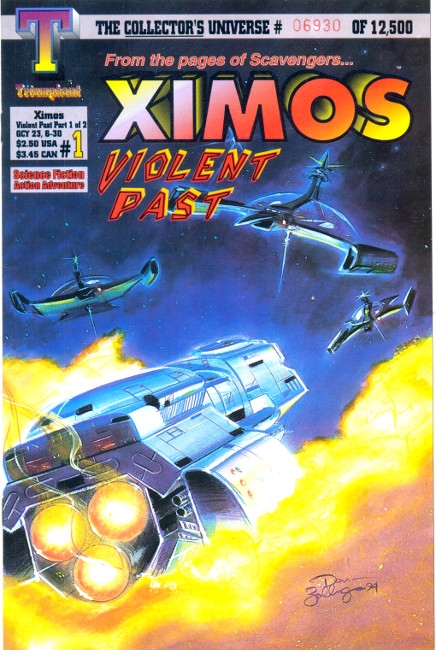
Just kinda randomly picking through the comics, stated print runs of between about 15,000 to 30,000 were the most common. The outlier was this freebie comic which, being free, naturally had the largest number that I saw:
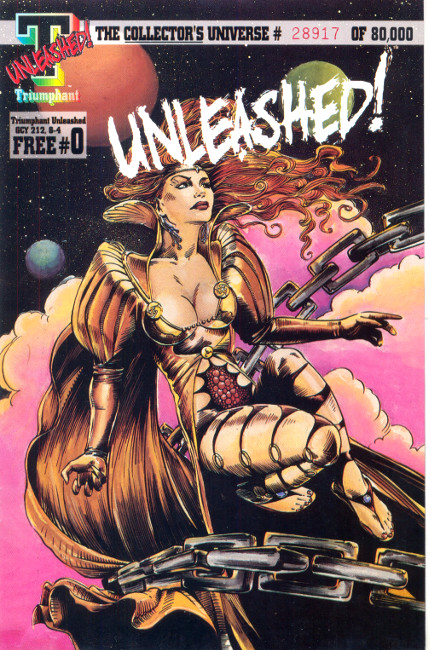
Not much else to say here really…their publishing strategy was to make their comics look more collectible, and, well, you can get copies for a buck a pop on eBay (one listing for a single issue for $5.99 including free shipping…which basically makes that a buck as well). Anyway, it was an interesting try at a gimmick building off a market with multiple price guides and an expanded emphasis on “limited editions” and “collectibles,” done in, it seems, by that market suddenly going away.
These is one more thing I’d like to point out, and that was this letter of encouragement from another comics personality of note that was printed on a back cover:
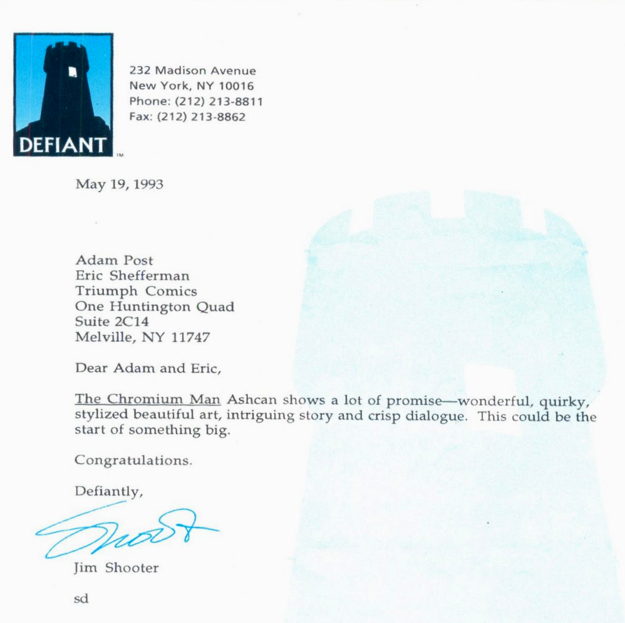
Which reminds me…I hope none of my comments here are taken as disparaging of the actual contents of these books. I’ve…never actually read a Triumphant comic. Big Jim liked what he saw, anyway. But this year’s worth of Triumphant books represented someone’s hard work and effort and dream to get their stories into print, and good for them. They had an interesting hook with the serial numbers to stand out on the shelves, but unfortunately things just didn’t work out. That’s just how it goes sometimes, and that’s especially how it went in comics during the mid-1990s.
Okay, next up in the variant cover-age…maybe some actual variant-ish type variant comics! Hey, did Defiant Comics have variants? I don’t remember.
Also, thanks to Customer Dave for lending me some of the Triumphant Comics from his collection for the production of this post. Hmmm, so long as I have ’em on hand, I’ll give one a read.








“Serial numbers printed on a comic’s cover are a sales enticement as well, but not in the same way. Different numbers on different copies do make them variants, when you get down to it, but, like no one’s literally “collecting them all.” Or, come to think of it, maybe someone’s trying…I’ve been in comics retail for nearly three and a half decades, I know what kind of stuff you weirdos get up to.”
I’ll just point out that one of the frequent commenters in this very comments section has a mission of buying up every single copy of an issue of a certain comic and destroying them, and has in fact (or claims to have) succeeded in destroying a significant portion of the print run. So there would be precedent!
Unless it’s someone else, that’s ME! Spitfire #1 – To Hell with it. I’ve already disposed of approximately 3% of the print run over the years (this is based on the best print numbers I could find about 30 years ago). And since I’ve been lazy over the last decade, they’ve just been building up at my storage. I’ve probably got another 15-20 long boxes worth out there right now. Not being closely associated with any shops for the last several years has really put a dent in my acquisitions. I don’t go out of my way to buy them up from Ebay listings. It’s the thrill of the hunt, out in the wild. I was at a flea market just a couple weeks ago and scored three more. I may very well die before my mission is complete. But, darn it, I’ll go down swinging!
Mr. Nick’s post reminds me of an unsuccessful TV pilot from the ’70s, “Jarrett,” starring Glenn Ford as an insurance investigator. The villain of the piece was primarily occupied with obtaining a set of rare documents akin to the Dead Sea Scrolls, but he had a secondary scam that involved destroying rare comics to increase the value of his own copies.
Said villain (played by the marvelous Sir Anthony Quayle) actually had an entire room devoted to his comics collection, with enlarged reproductions of comics covers hanging in glass frames from the ceiling. Oddly, despite his interest only in rare, valuable comics, the posters are all from then-recent DC comics, including SUPERMAN #261, WONDER WOMAN #204, KAMANDI #3, and GHOSTS #12. Actually, one can be more specific than a mere “then-recent”; these were all dated February 1973. Obviously, whoever had the job of creating the posters simply made one stop at the nearest convenience store for his models (or else the job was handed over to DC, who saw it as an opportunity to promote their latest releases).
Alas, in the climactic battle between Jarrett and the villain’s Oddjob-like henchman, all of the posters are shattered, and the comics are knocked to the ground.
I could see a Jorge Luis Borges story come to life out of this scenario.
Someone hunts down every copy of a certain comic series in order to destroy them.
Everyone remembers this certain comic as having existed. There are even details of the comic recorded in multiple sources. Some even claim they once owned said comics.
Yet, no one can seem to actually prove that such a comic ever existed.
It could be interesting.
@John Lancaster: God speed on your quest Sir! Still a worthy ambition.
Assuming the numbers on the Mad issues are relatively close to their print runs, they were still shifting a lot of units as recently as 1995. 900k! Big step down from the 2m+ in 1968, but still streets ahead of the typical superhero comic of the time I would have thought.
The side benefit of continuing this series of posts is that, when something unrelated to this topic (like the previous one on Swamp Thing history) pops up amidst them, it’s basically a variant!
It’s probably a really boring answer, but I’d love to know how they decided on those 4 numbers for the Mad variants.
Hey, Mike, I read Games and Omni when I was that age also! I’ve thought recently how I wish I still had my Omnis, but I had totally forgotten about Games. That was a fun mag. And, as I’ve just discovered, is impossible to search for on eBay.
STOP THE PRESSES! Games still exists! I had no idea.
“Mr. Nick’s post reminds me of an unsuccessful TV pilot from the ’70s, “Jarrett,” starring Glenn Ford as an insurance investigator.”
An insurance investigator who teamed up with Batgirl:
https://www.imdb.com/title/tt0070237/mediaviewer/rm2834180608/
I would have watched that every week.
More revelations! I was looking at an issue of Games on the Internet Archive and thought to myself “This looks like a Playboy publication.” And it was! Something else I had no idea about.
Since this issue of Mad came out in 1968, I wonder if it was parodying the Beatles’ White Album from the same year, which also originally had the serial numbers stamped on the front?
John Lancaster: “Spitfire #1”
That isn’t even the worst New U comic- that would be Marc Hazzard: Merc!
Pete: “Since this issue of Mad came out in 1968, I wonder if it was parodying the Beatles’ White Album from the same year, which also originally had the serial numbers stamped on the front?”
Makes sense!